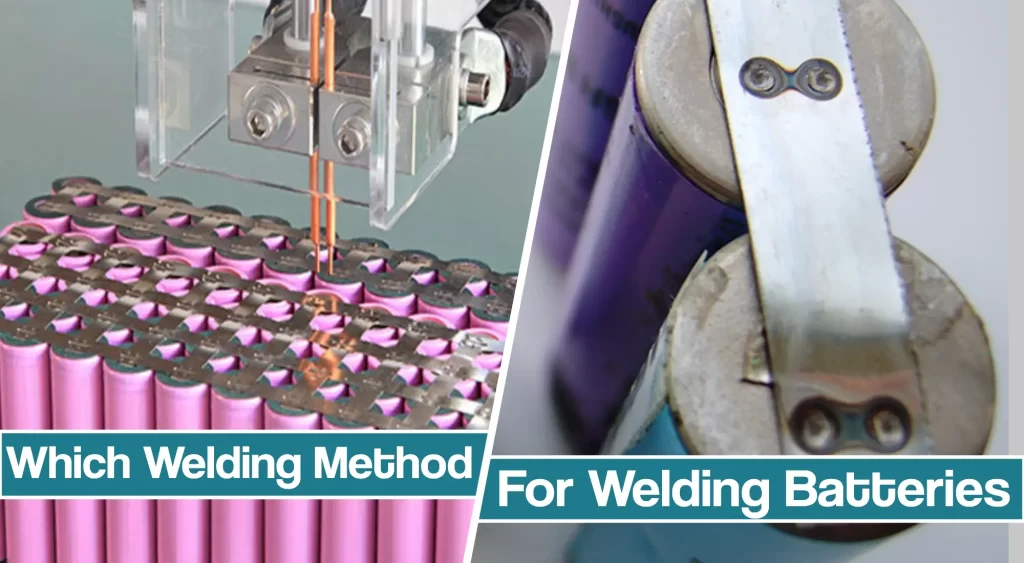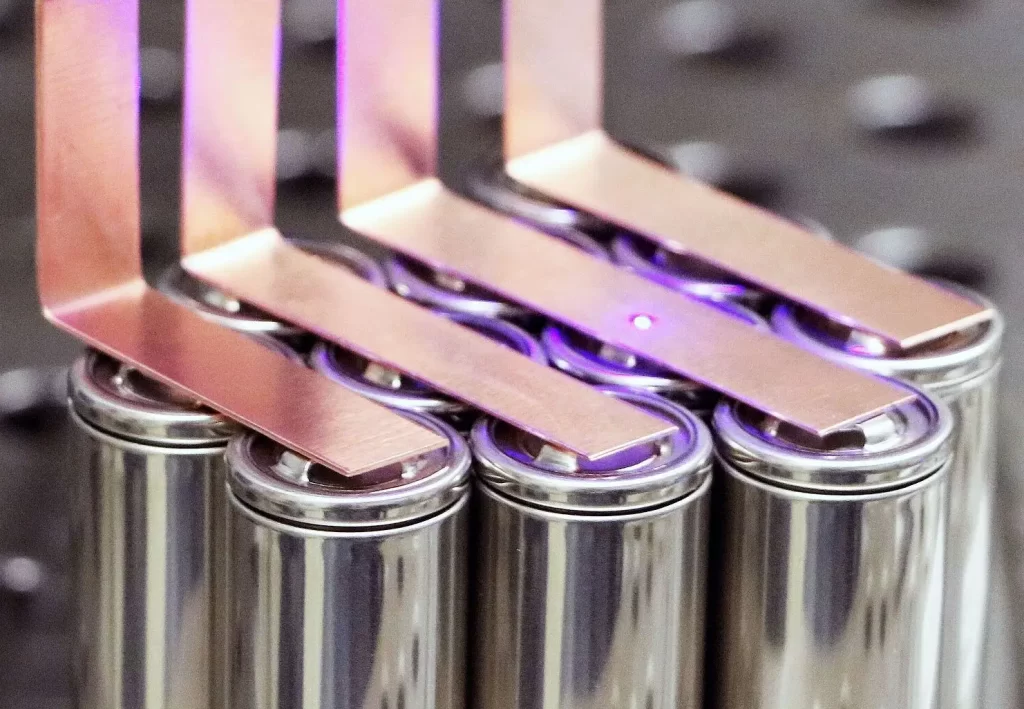With the ever-increasing need for complex battery packs, their welding methods have evolved in order to provide the most efficient joining methods for cells’ terminals.
The most crucial aspect to consider when welding a battery pack is the contact resistance between the cell and the connection tab or a buss bar. This variable needs to be minimized to prevent unnecessary energy loss in the form of heat generation.

Additionally, the quality of weld, conductivity, production costs and load bearing of the joint is what a perfect welding technique choice solves.
In this article, we will discuss multiple welding methods from resistance welding to laser welding technologies and see when one is better suited over another.
Welding Tabs and Buss Bars To Terminals
To join cells into a battery pack, the cell terminals are welded together in serial or parallel to achieve either a higher voltage, higher capacity, or both. But welding terminal welds is challenging because minimizing heat input is necessary to prevent cell or terminal damage.
The vital variables are the tab thickness and terminal and tab materials from a welding perspective. It is more straightforward to weld tabs and terminals to buss bars because this doesn’t require as much penetration or heat input control compared to tab-to-terminal welds.
So, let’s see which welding method works best for what application.
Resistance Spot Welding
Resistance welding nickel tab material works great up to 0.015-inch thickness, and nickel or steel clad copper tabs up to 0.012-inch thickness to many terminal materials.
Resistance spot welding is an extremely efficient and cost-effective method for joining tabs on a wide range of battery types and sizes, including Li-ion 18650 cells.
The resistance spot welder can use DC inverter closed-loop and capacitor discharge power supplies, but it can also be battery powered. Thanks to its closed-loop feedback control, polarity switching, fast rise times, and options for force sensing and displacement, the resistance welding process allow fine-tuning welds and high-quality results.
The resistance welding typically uses a dual pulse. The first pulse cleans the surface from oxides and contaminants, and the second pulse welds the two metal pieces together. Metals exhibit resistance to electrical current flow, resulting in increased heat in the material. In this case, in the spots where the spot welder made contact with the electrodes. After the metal has melted, the two pieces fuse together and create a “nugget” weld.
For nickel tab material with a lower thickness than 0.007-inch, there is no need for modifications. However, beyond this thickness, it is necessary to stamp the slot and projections in the material to prevent electrode wear and electrical shunting. The projections act as the point where energy concentrates in the weld and reduce the wear of spot welder electrodes.
Micro-TIG Welding
Micro-TIG welding is based on a tungsten inert gas welding process but at short intervals thanks to the pulsed arc welding. The TIG pulse is commonly used to reduce heat input in typical gas tungsten arc welding applications for welding thin sheet metal.
Similarly, we use short TIG pulses with low amperage to weld tabs and buss bars to cell terminals. It’s a very clean method that efficiently welds dissimilar material combinations. Its best used for aluminum, copper, nickel, and steel. It’s especially important to use TIG pulse when welding copper to avoid porosity in the weld.
The micro-TIG is used for butt, fillet, and lap welds very effectively, and it can go beyond the 0.02″ thick copper without problems. But, it’s interesting to note that there are no reports of micro-TIG welding in the manufacturing of electric vehicles battery packs. Perhaps because the TIG welding process requires the shielding gas, increasing the cost and complexity of the job.
Laser Beam Welding
Laser beam welding (“LBW”) is a welding process that uses a concentrated laser beam as a heat source to fuse materials together. There are a few components of a laser welding machine.
But, the three most important are a lasing medium, a lasing cavity, and a pumping source.
The cavity design determines the form of the outgoing beam, and the reflecting lenses focus the laser.

It is possible to modify the laser shape and focus to achieve different welding results with a laser welding machine. For example, you can create a narrow, wide, or tiny spot size.
This high degree of laser output allows variability for welding thick or thin buss bars and tabs to cell terminals. It works great with thin or thick tabs, and materials like copper, aluminum, nickel, and steel.
A general rule of thumb is that you should weld a thinner tab than the terminal because otherwise, you can penetrate the cell casing.
Perhaps the best advantage of laser beam welding in battery packs is that there is no limitation on the proximity of the welds. Therefore, it is possible to laser weld any pattern of spot welds on the tab, allowing you to achieve the strength requirements.
Usually, the peel strength is a metric for the weld quality of welded cells. The peel strength, by definition, is the average force required to part two bonded materials. If a project demands specific peel strength of welded tabs to cell terminals, the laser beam welding process is one of the best ways to precisely achieve it.
However, the vibration strength is also vital, especially for a battery pack exposed to it. The dynamic loads “attack” the weld in every direction, so it is a good idea to make a circular shape laser spot weld pattern on the battery terminals.
Conclusion
While laser welding offers the best tab welding results, resistance welding is still very common with brands that manufacture batteries. However, laser welding allows much finer welding in the battery industry and has significant advantages in achieving materials joining requirements.
This was an overview of applying the right technology for welding batteries, buss bar welding, and tab welding to the battery terminals. The most cost-effective method if you plan to do battery welding yourself is probably the spot welding mechanism. Still, you must be careful because battery cans can vent or explode if overheated.
It is especially tricky to weld thick tab materials if you haven’t done something like this before, so make sure you research the safety of battery terminal welding before attempting this yourself.
Sources:
- Welding methods for electrical connections in battery systems
- What is Laser Welding? at Twi-global
- Let’s Talk about Battery Spot Welders at International Manufacturing Teletrading Sources





